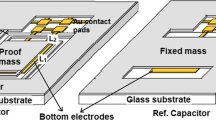Abstract
The present paper discusses a method for testing a MEMS capacitive accelerometer structure through electrical actuation. The response of a standard MEMS capacitive accelerometer structure for different electrical actuation voltages has been analyzed. The accelerometer structure along with a capacitance sensing integrated circuit (IC) MS3110 is modeled and simulated. A set of proto-type accelerometer structures is fabricated and packaged in PGA packages. The packaged MEMS structures and MS3110 IC are integrated on a printed circuit board. The MEMS structure is actuated by applying the electrical signal through the actuation fingers and the change in capacitance is measured by the MS3110 IC. The simulated and measured results show some interesting phenomenon like dipping and frequency doubling which are useful for initial testing and characterization of a MEMS accelerometer structure.









Similar content being viewed by others
References
Amini BV, Ayazi F (2005) Micro-gravity capacitive silicon-on-insulator accelerometers. J Micromech Microeng 15:2113–2120
Allen HV, Terry SC, Bruin DWD (1989) Accelerometer systems with self-testable features. Sens Actuator 20:153–161
Bao M (2005) Analysis and design principles of MEMS devices. Elsevier, Amsterdam
Baxter LK (1997) Capacitive sensors, design and applications. IEEE Press, New York
Boser BE (1997) Electronics for micromachined inertial sensors. IEEE International Conference on Solid-State Sensors and Actuators, pp 1169–1172
Bao M, Yang H, Yin H, Shen S (2000) Effect of electrostatic forces generated by the driving signal on capacitive sensitive devices. Sens Actuator A Phys 84:213–219
Chau KHL, Sulouff RE (1998) Technology for the high-volume manufacturing of integrated surface-micromachined accelerometer products. Microelectron J 29:579–586
Che L, Xiong B, Wang Y (2004) Effects of bias voltage polarity on differential capacitive sensitive devices. Sens Actuator A Phys 112:253–261
Chen W, Chen X, Zheng G, Liu X, Zhang H (2009) Analysis of the self-test characteristics of a micromachined accelerometer. In: Proceedings of International Conference on Nano/Micro Engineered and Molecular Systems, (NEMS 2009), China, 5–8 Jan 2009, pp 396–399
Lemkin M, Boser BE (1999) A three-axis micromachined accelerometer with a cmos position-sense interface and digital offset-trim electronics. IEEE J Solid-State Circuits 34:456–468
MS3110 (2004) MS3110 datasheet and users manual. http://www.irvine-sensors.com/pdf/MS3110BDPC_users_manual_USE.pdf
Xuemei H, Linhong T (2008) Research and analysis of bias voltage on variable-capacitance micromechanical accelerometer. In: Proceedings of International conference on Intelligent Information Hiding and Multimedia Signal Processing, (IIH-MSP 2008), Harbin, China, 15–17 Aug 2008, pp 1490–1493
Acknowledgments
The authors would like to thank Department of Information Technology (DIT), Govt. of India for their financial support and SCL, Chandigarh, India for packaging of the fabricated MEMS structures.
Author information
Authors and Affiliations
Corresponding author
Rights and permissions
About this article
Cite this article
Kar, S.K., Swamy, K.B.M., Mukherjee, B. et al. Testing of MEMS capacitive accelerometer structure through electro-static actuation. Microsyst Technol 19, 79–87 (2013). https://doi.org/10.1007/s00542-012-1611-0
Received:
Accepted:
Published:
Issue Date:
DOI: https://doi.org/10.1007/s00542-012-1611-0




